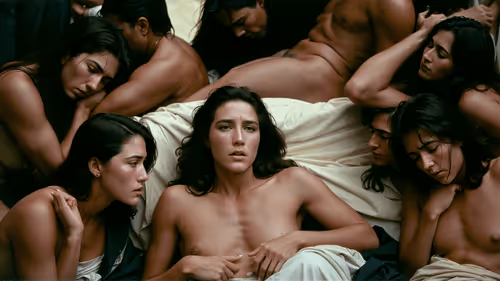"Iconoclast" immerses us within an evocative moment of tension between sacred tradition and defiant rebellion. At the image's heart stands a solitary figure—a punk-inflected ascetic, whose tattooed skin and piercing-covered visage starkly contrast with the ceremonial saint-like robe they wear. Their shaved head, ink-marked body, and serene yet unyielding posture radiate a quiet insurrection, upending traditional portrayals of saintliness and purity.
Encircled tightly by a captivated throng, the figure appears both revered and isolated, evoking images of martyrdom and celebrity simultaneously. The cathedral's towering columns and dimly lit gothic arches frame this central spectacle, emphasizing the paradox between the hallowed environment and the figure's radical presence. The hands of the crowd extend upward in adulation, desperation, or curiosity—each person recording the event on cameras, amplifying the ritualistic air of modern idolatry.
Captured in the muted, grainy textures, this scene conjures historical memories of iconoclastic upheavals and societal shifts. Blending visual elements of religious renaissance art with punk counterculture, the photograph proposes a provocative alternate history, challenging viewers to reflect on tensions between institutional power, individual agency, and societal transformation. "Iconoclast" thus becomes an invitation—not just to witness rebellion, but to question our collective definitions of sanctity, authority, and the revolutionary potential of individual dissent.
